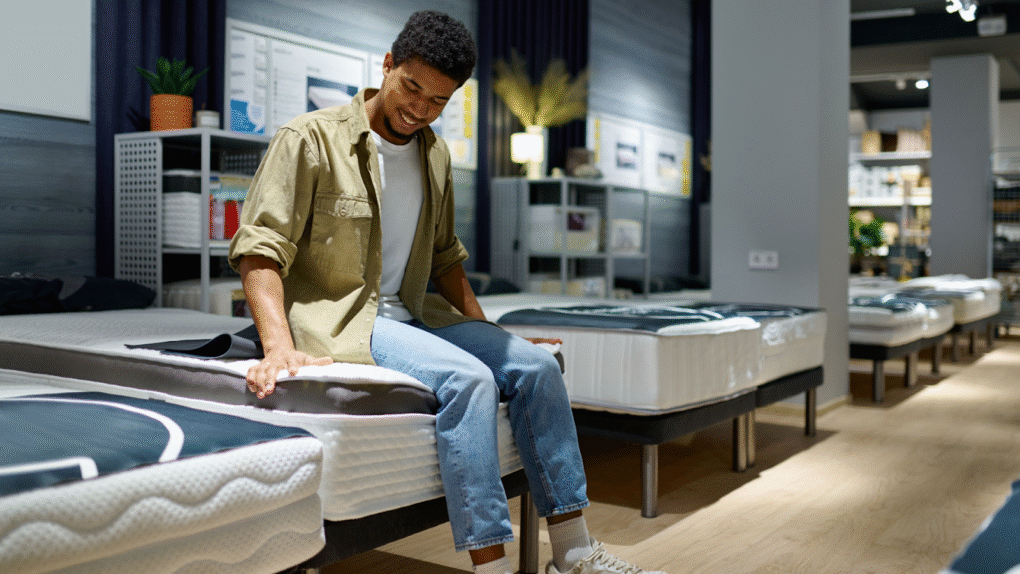Poor sleep affects millions of people, yet many don’t realize their mattress could be the culprit. We spend a third of our lives sleeping, and the quality of that rest greatly influences our overall health and well-being. Whether you’re upgrading your bedroom or trying to transform your living room into a stylish yet functional sleeping space, like with a daybed, sleeper sofa, or floor mattress, the right mattress makes all the difference.
With countless options available today, finding the perfect fit can feel overwhelming. But it doesn’t have to be complicated. Understanding what makes a mattress truly comfortable for your unique needs, considering materials, firmness, sleep position, and space, is the first step. This guide will help you make an informed choice, whether it’s for your primary bed or a multipurpose living area.

Understanding Different Mattress Types
When you’re ready to buy a mattress, knowing the different types available helps narrow down your options. Each material offers unique benefits and drawbacks that can significantly impact your sleep quality.
Memory Foam Mattresses
Memory foam mattresses contour to your body, creating a hugging sensation that many people love. They’re excellent for pressure relief and motion isolation, making them ideal for couples. However, traditional memory foam can trap heat, which might be uncomfortable for hot sleepers. Modern versions often include cooling gel or other temperature-regulating features.
Hybrid Mattresses
Hybrid mattresses combine the best of both worlds by pairing memory foam or latex with innerspring coils. This combination provides the pressure relief of foam with the bounce and breathability of springs. Many consider hybrid mattresses to be the most comfortable mattress option because they offer balanced support and comfort for various sleep styles.
Latex Mattresses
Latex mattresses are naturally breathable and durable, offering a bouncy yet supportive feel. They’re also naturally resistant to dust mites and mold, making them a great choice for people with allergies. Latex can be either natural or synthetic, with natural latex being more expensive but also more eco-friendly.
Innerspring Mattresses
Traditional innerspring mattresses use coil systems for support, topped with comfort layers. They’re typically more affordable and offer good airflow, but they may not provide enough pressure relief for side sleepers. Modern innerspring mattresses often include additional comfort layers to address this issue.
The variety of options means there’s likely a perfect match for your needs, but understanding these differences helps you focus on what matters most for your sleep comfort.
Determining Your Sleep Style and Preferences
Your sleeping position and personal preferences play a crucial role in choosing a comfortable mattress. Different positions require different levels of support and pressure relief.
Side Sleepers Need Pressure Relief
Side sleepers make up the majority of people and need mattresses that cushion pressure points like hips and shoulders. The best mattress for side sleepers typically falls in the medium-soft to medium-firm range. This allows the mattress to contour around curves while still providing adequate support for the spine.
Back Sleepers Require Balanced Support
Back sleepers need a mattress that maintains the natural curve of their spine without letting their lower back sink too deeply. Medium-firm mattresses usually work best, providing enough support while still offering some comfort. Too soft, and you’ll sink in too much; too firm, and you might experience pressure points.
Stomach Sleepers Need Firm Support
Stomach sleepers require firmer mattresses to prevent their midsection from sinking too deeply, which can cause back pain. A firm mattress keeps the spine aligned and prevents the uncomfortable arching that can occur with softer surfaces.
Consider Your Body Weight
Your weight also influences what feels comfortable. Heavier individuals typically need firmer mattresses for proper support, while lighter people might prefer softer options. This is where personal preference really matters in your decision-making process.
Understanding your sleep style helps you ask the right question: “What mattress should I buy?” becomes much easier to answer when you know your specific needs.
Key Features That Make a Mattress Comfortable
Beyond basic materials and firmness, several features can make or break your sleep experience. These elements often separate good mattresses from great ones.
Temperature Regulation
Nobody wants to wake up in a sweat. Look for mattresses with cooling features like gel-infused foam, breathable covers, or coil systems that promote airflow. Some newer mattresses even include phase-change materials that actively regulate temperature throughout the night.
Motion Isolation
If you share your bed, motion isolation becomes crucial. Memory foam and hybrid mattresses with pocketed coils excel at preventing movement from transferring across the bed. This means you won’t wake up every time your partner tosses and turns.
Edge Support
Good edge support makes your mattress feel larger and prevents that rolling-off feeling when you sit or sleep near the edges. This feature is especially important for couples who need to utilize the full surface area of their mattress.
Durability and Longevity
A comfortable mattress should stay comfortable for years. Look for high-quality materials and construction that can withstand regular use. Generally, you should invest in a new mattress every 8-10 years.
These features work together to create the overall comfort experience, so consider which ones matter most to you based on your specific situation and preferences.
Practical Shopping Tips
Armed with knowledge about mattress types and features, you’re ready to start shopping. This mattress buying guide approach will help you make the best decision.
Set a Realistic Budget
Quality mattresses range from a few hundred to several thousand dollars. While you don’t need to spend a fortune, investing in a good mattress is investing in your health. Plan to spend at least $800-1200 for a quality queen-size mattress that will last.
Take Advantage of Sleep Trials
Many online mattress companies offer sleep trials ranging from 90 days to a full year. These trials let you test the mattress in your own home, which is much more accurate than a quick store test. Don’t skip this valuable opportunity to make sure your choice is right.
Read Reviews Carefully
Look for reviews from people with similar sleep styles and preferences. Pay attention to long-term reviews that discuss how the mattress held up over time. Professional reviews can also provide valuable insights into construction quality and performance.
Consider Your Current Setup
Make sure your new mattress will work with your existing bed frame and foundation. Some mattresses require specific support systems to maintain their warranty and performance.
Smart shopping involves patience and research, but the payoff is years of better sleep and improved health.
Mattress Comparison Table
| Mattress Type | Best For | Firmness Range | Price Range | Durability |
| Memory Foam | Side sleepers, pressure relief | Soft to Medium-firm | $400-2000 | 6-8 years |
| Hybrid | All sleep positions, couples | Medium-soft to Firm | $600-3000 | 7-10 years |
| Latex | Hot sleepers, eco-conscious | Medium to Firm | $800-2500 | 10-15 years |
| Innerspring | Back/stomach sleepers, budget | Medium-firm to Firm | $200-1500 | 5-7 years |
Common Questions About Choosing Your Perfect Mattress
1. Which type of mattress is best for comfortable sleep?
Latex mattresses tend to be rated as the most comfortable mattress type. This eco-friendly material offers plenty of support across the entire mattress while naturally regulating temperature for optimal sleep comfort.
2. What is the most comfortable material for a mattress?
Latex mattresses are often considered the most comfortable due to their unique combination of support and pressure relief. They offer the contouring benefits of memory foam with the responsiveness of innerspring systems.
3. How often should I replace my mattress?
Most experts recommend replacing your mattress every 8-10 years, though this can vary based on mattress quality, usage, and personal comfort preferences. Signs it’s time include sagging, discomfort, or poor sleep quality.
Your Path to Better Sleep Starts Here
Choosing the right mattress isn’t just about comfort; it’s about investing in your overall health and well-being. The perfect mattress supports your body, regulates temperature, and provides the foundation for restorative sleep night after night.
Remember that what works for others might not work for you. Your sleep position, body weight, temperature preferences, and partner’s needs all factor into the decision. Take time to research, test options when possible, and don’t rush the process.
The mattress industry continues to innovate, offering more options than ever before. Whether you prefer the classic feel of innerspring, the contouring embrace of memory foam, or the balanced support of a hybrid, there’s a perfect match waiting for you.
Your future self will thank you for taking the time to choose wisely; after all, better sleep means better days ahead.
